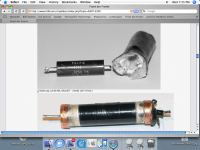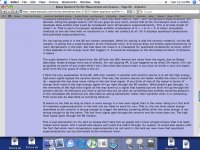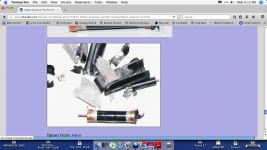Ridikas, please don't get yourself into 'trouble' here. I need you to stick around, and I have had to keep out of 'trouble' as best that I can in the same way, or they would show me the 'door', not that many have not tried over the decade. It is interesting that you also have a degree in Physics. Why is it that you, I, Nelson Pass, and the late Charley Hansen all have degrees in physics rather than engineering? Is it that we sought a 'higher calling'? Like maybe, deeper understanding of how things really work, rather than just training for a future job? I have nothing against engineers, I am one these days, even if I don't have a formal degree in it. If anyone doesn't believe me, tuff!
Now, let me (again) try to keep our facts straight about Bybee. FIRST, we are talking about three different processes that Bybee has used to make his devices:
1. The original quantum device with a built in, (or parallel) resistor. This is the high current version, that ridikas and I have looked at.
2. The SLIPSTREAM device, that is most probably made of massively paralleled Buckytubes, effectively reducing the many thousands of ohms of a single Buckytube, to 0.025 ohms. This was the device that SY tested. It has a max current of about 4A.
3. The quantum field device that consists of an exotic material that is placed as a coating on a metallic surface, then covered with a thin wood or plastic case. This is the part that Scott tested. I have never tried this particular part, but I had great success with a similar Bybee part called an IQSE that looks similar to the part that Scott tried.
I hope this keeps the confusion down to a minimum.
Now, let me (again) try to keep our facts straight about Bybee. FIRST, we are talking about three different processes that Bybee has used to make his devices:
1. The original quantum device with a built in, (or parallel) resistor. This is the high current version, that ridikas and I have looked at.
2. The SLIPSTREAM device, that is most probably made of massively paralleled Buckytubes, effectively reducing the many thousands of ohms of a single Buckytube, to 0.025 ohms. This was the device that SY tested. It has a max current of about 4A.
3. The quantum field device that consists of an exotic material that is placed as a coating on a metallic surface, then covered with a thin wood or plastic case. This is the part that Scott tested. I have never tried this particular part, but I had great success with a similar Bybee part called an IQSE that looks similar to the part that Scott tried.
I hope this keeps the confusion down to a minimum.
Last edited:
Ridikas, in the B device that you have looked into, there is a ceramic tube that the resistor fits in. The coated ceramic tube IS the Bybee device, the resistor is necessary but actually put inside for convenience and to shorten the electron path from each end of the Bybee device. The inner resistor element is Be, yes the metal, surrounded by BeO as an insulator. This is why they cost big bucks!
what is lazy engineering about applying LR4? It still takes considerable skill to do it right. The better loudspeakers become (and they do!), the more they will all sound alike. They have to, when they converge to transparency. I can tell you now, that all transparent speakers will eventually sound completely identical. Just like many DACs and amplifiers do at the moment already.
BTW, except for some possible offset in acoustic center between drivers, LR4 is both time aligned and coherent. That is one of its charms.
I can only assume this is the quote ridikas was thinking of, but from boring old signal transduction perspective, it makes sense. Although different rooms are going to necessitate different power responses. Doubtful we'll see the same sort of homogeneity in speakers as we do in the preceding electronics.
As far as the difference between caps is concerned, we have found that certain manufacturing techniques that are used to make caps can change the sound quality of the caps, even if they are composed of the same material, and have the same measured value. Usually this can be in the lead material, (magnetic or pure copper) and how it is attached to the capacitor body. Military grade caps often have magnetic (copper clad) leads as these leads do not break as easily a pure copper under heavy vibration. They may change the sound quality, negating the advantage of the other workmanship or material quality.
This is why I stick to cap manufacturers that I have found sound generally good, and avoid most others, with my own designs.
This is why I stick to cap manufacturers that I have found sound generally good, and avoid most others, with my own designs.
Ridikas, in the B device that you have looked into, there is a ceramic tube that the resistor fits in. The coated ceramic tube IS the Bybee device, the resistor is necessary but actually put inside for convenience and to shorten the electron path from each end of the Bybee device. The inner resistor element is Be, yes the metal, surrounded by BeO as an insulator. This is why they cost big bucks!
Thank you for clarification. I forgot about the ceramic tube. Resistor is inside of this tube, which is coated in something, copper end caps are soldered on each end of the tube/resistor. Then wrapped in soft material and dipped in glue of some sort.
It's an interesting device. I was not aware of beryllium or beryllium oxide being used, but that will certainly drive the price up.
I'll try and behave 🙂
Ridikas, in the B device that you have looked into, there is a ceramic tube that the resistor fits in. The coated ceramic tube IS the Bybee device, the resistor is necessary but actually put inside for convenience and to shorten the electron path from each end of the Bybee device. The inner resistor element is Be, yes the metal, surrounded by BeO as an insulator. This is why they cost big bucks!
John, if Bybee devices did what Jack claims, why are the medical, defense, aerospace, and particle physics guys not knocking down his door trying to give him bags of money?
For that matter, why wouldn't the Chinese already have stolen it?
I can only assume this is the quote ridikas was thinking of, but from boring old signal transduction perspective, it makes sense. Although different rooms are going to necessitate different power responses. Doubtful we'll see the same sort of homogeneity in speakers as we do in the preceding electronics.
Yes. Thanks!
John, Probably not a higher calling. I know some very good physicists with tin ears.
One possibly huge factor is that people appear to vary a great deal in how their brains process sound, music, distortion, pitch, etc. Standard audiology testing does not measure any of that and there is not a whole lot of research on some things that would be clearly applicable to some arguments here. Yet, according to Earl Geddes, we know quite a bit about how roughly 95% of the population hears, perhaps significantly due in part to his work for the area of distortion perception. For the top 5% there is no specific research, and no test methods to differentiate that group have even been developed. According to Geddes nobody cares enough to pay for it.
In this forum of mostly old men, there are some people with very technical backgrounds, and perhaps somewhere around 95% of them probably fall into the 95% group of hearing ability (we don't actually know, the distribution has never been measured).
Trying to find people who are knowledgeable and experienced audio designers, who are in the top 95% of hearing ability, and who are willing to stick around here and participate in never ending disagreements with others who hear differently is probably not going to be easy. Counting you, there might be one. Or, maybe a small few more who are less vocal.
One possibly huge factor is that people appear to vary a great deal in how their brains process sound, music, distortion, pitch, etc. Standard audiology testing does not measure any of that and there is not a whole lot of research on some things that would be clearly applicable to some arguments here. Yet, according to Earl Geddes, we know quite a bit about how roughly 95% of the population hears, perhaps significantly due in part to his work for the area of distortion perception. For the top 5% there is no specific research, and no test methods to differentiate that group have even been developed. According to Geddes nobody cares enough to pay for it.
In this forum of mostly old men, there are some people with very technical backgrounds, and perhaps somewhere around 95% of them probably fall into the 95% group of hearing ability (we don't actually know, the distribution has never been measured).
Trying to find people who are knowledgeable and experienced audio designers, who are in the top 95% of hearing ability, and who are willing to stick around here and participate in never ending disagreements with others who hear differently is probably not going to be easy. Counting you, there might be one. Or, maybe a small few more who are less vocal.
Last edited:
As I mentioned before C dV/dT + V dC/dT = i. Lots of folks tried to explain to me about how the result must be linear from what they had learned. Sorry it took me a bit to figure out why they were confused.
The dC/dT term is influenced not just by the function of V but also as shown in one of the BT threads to be influenced by silly things like G. As there is a baseline of around .01 Gs of vibration that produces dC/dT and thus di/dT that is unrelated to V in use.
Now I did measure this dG effect years back and showed that issues such as how capacitors are mounted with regard to their plate orientation would affect performance.
Most researchers have a good grasp of what harmonic distortion does to perception, it is also recognized that signals essentially uncorelated with the signal can be masked under many conditions but NOT always.
Yes there was a fad of glueing capacitors to the circuit cards and claiming improvements in the sound quality. In some cases it just might have been true.
The dC/dT term is influenced not just by the function of V but also as shown in one of the BT threads to be influenced by silly things like G. As there is a baseline of around .01 Gs of vibration that produces dC/dT and thus di/dT that is unrelated to V in use.
Now I did measure this dG effect years back and showed that issues such as how capacitors are mounted with regard to their plate orientation would affect performance.
Most researchers have a good grasp of what harmonic distortion does to perception, it is also recognized that signals essentially uncorelated with the signal can be masked under many conditions but NOT always.
Yes there was a fad of glueing capacitors to the circuit cards and claiming improvements in the sound quality. In some cases it just might have been true.
Last edited:
The core of the B devices is made exclusively for the military. They use it all over the place, so I would presume.
Last edited:
John, Probably not a higher calling. I know some very good physicists with tin ears.
One possibly huge factor is that people appear to vary a great deal in how their brains process sound, music, distortion, pitch, etc. Standard audiology testing does not measure any of that and there is not a whole lot of research on it. According to Earl Geddes, we know quite a bit about how roughly 95% of the population hears. For the top 5% there is no specific research, and no test methods to differentiate that group have even been developed.
In this forum of mostly old men, there are people some people with very technical backgrounds, and perhaps somewhere around 95% of them probably fall into the 95% group of hearing ability (we don't actually know, the distribution has never been measured).
Trying to find people who are knowledgeable and experienced audio designers, who are in the top 95% of hearing ability, and who are willing to stick around here and participate in never ending disagreements with others who hear differently is probably not going to be easy. Counting you, there might be one. Or, maybe a small few more who are less vocal.
Old men hear VERY poorly as a group compared to the general population. I'm not sure where you pull your numbers from, but the odds of a 70+ year old male having "95th percentile hearing" is probably close to nil.
Hearing Loss Increases With Age | NIDCD
No offense to any in present company, we'll all be there someday, hopefully.
John, if Bybee devices did what Jack claims, why are the medical, defense, aerospace, and particle physics guys not knocking down his door trying to give him bags of money?
For that matter, why wouldn't the Chinese already have stolen it?
I was going to say, 1.) I do nanomagigies research for molecular diagnostics, the explanations for all their material science don't fly. Also this means 2.) I use a lot of really expensive, sensitive test equipment where any of these improvements would greatly positively affect our ability to test/visualize our research. Lower noise in read electronics? Heck yes. Pretty please all day any day.
Those instruments all use normal, sober electronics done extremely well. Audio's fun, but let's be honest, state of the art electronics it gets as largess from other infinitely more demanding industries.
Old men hear VERY poorly as a group compared to the general population. I'm not sure where you pull your numbers from, but the odds of a 70+ year old male having "95th percentile hearing" is probably close to nil.
Hearing Loss Increases With Age | NIDCD
No offense to any in present company, we'll all be there someday, hopefully.
Not talking about minimum loudness to detect a given frequency, which is what the numbers you mention primarily refer to.
If the volume is turned up more frequencies become audible. And one can be very good at hearing distortion in the frequency range that one can hear.
Last edited:
Beryllium oxide ceramics have extremely high thermal conductivity, I'm sure the military uses them.
For that matter, why wouldn't the Chinese already have stolen it?
That's not how they see it and a common misconception, I'm not defending it, it's just a different perception
Here is a safe subject. Think about the SIZE of the B resistor and its power rating of 25W. How can they do it? BeO of course, but pure Be is the inner conductor, why would they bother to do it? (think Physics)
Here is a safe subject. Think about the SIZE of the B resistor and its power rating of 25W. How can they do it? BeO of course, but pure Be is the inner conductor, why would they bother to do it? (think Physics)
Remains extremely stable at high temperatures.
Here is some more info:
Attachments
Last edited:
- Status
- Not open for further replies.
- Home
- Member Areas
- The Lounge
- John Curl's Blowtorch preamplifier part III



